Solar lights, an innovation that uses photovoltaic cells to convert sunlight into electricity, have revolutionized outdoor lighting. By using the sun’s rays, these lights offer an environmentally friendly and cost-effective solution to lighting homes, streets, and outdoor spaces.
Solar lights typically rely on two primary components: a solar panel to gather sunlight and a rechargeable battery to store this energy for use after dark. The emergence of solar lights without batteries or sunlight presents a significant leap forward in sustainable lighting technology.
Moving beyond the confines of sunlight hours and the need for battery storage, these innovative solar lights promise consistent, sustainable illumination. Delving into this article, you will discover the intricacies of this groundbreaking technology, its potential benefits, and its future implications.
Solar Lights and Their Components
Basic Principles of Solar Energy Conversion
Solar lights harness the power of the sun through photovoltaic cells. These cells contain semiconductors (usually silicon), which absorb sunlight. The energy absorbed excites the electrons in the semiconductor, creating an electric current.

Solar Panels and Batteries in Solar Lights
Solar panels and batteries are crucial in traditional solar lights. The solar panel collects sunlight during the day, converting it into electricity. This electricity charges the battery, which powers the light after sundown.
Do Solar Panel Lights Need a Battery?
In traditional solar lights, batteries are essential for storing energy. They allow the lights to function during the night or during periods of low sunlight. Without a battery, the light would only work when the sun is shining directly on the solar panel, making it less practical.
The Function of Batteries in Solar Lights
The battery’s role in a solar light is to store excess energy generated during the day. This stored energy powers the light when sunlight is insufficient, such as during night or cloudy conditions.
Can a Solar Panel Light Work Without a Battery?
Though batteries play an integral role in current solar light technologies, they have limitations. They have finite lifespans and require regular replacement. Disposal of old batteries also poses environmental concerns.
New innovations are exploring the possibility of solar lights functioning without a battery. The concept might sound far-fetched, but advancements in technology are bringing it closer to reality.
What Happens If the Battery in Your Solar Light Dies?
A dead battery in a solar light means the stored energy source is gone. As a result, the light won’t function until the battery is replaced.
When a solar light battery dies, it can be replaced. However, the dead battery should be recycled responsibly to minimize environmental harm.
How to Connect a Light Directly to a Solar Panel
Connecting a light directly to a solar panel requires a deep understanding of electrical wiring and safety measures.
- Choosing the Correct Solar Panel and Light Bulb: It is crucial to start by selecting a solar panel and light bulb that work well together. The panel’s power output should be sufficient to drive the light bulb.
- Gathering the Necessary Tools and Equipment: This includes a multimeter to measure voltage and current, wire strippers, connecting wires, a soldering iron, and safety equipment such as gloves and safety glasses.
- Connecting the Wires: The positive terminal of the solar panel (usually red) should be connected to the positive end of the light bulb, and similarly for the negative ends.
- Testing the Connection: Use the multimeter to check if the bulb is getting the necessary voltage and current. This step is important to ensure that the connection is made properly and safely.
Always remember to take necessary safety precautions while handling these electrical components. If you lack experience or knowledge in this area, it would be safer to hire a professional or seek expert guidance.

Limitations of Traditional Solar Lights
Traditional solar lights have played a vital role in the shift towards more sustainable forms of energy. However, these lights are not without their drawbacks.
Dependency on Sunlight
The most significant limitation of traditional solar lights is their dependency on sunlight. They need sufficient sunlight to charge the batteries, and this is not always possible, especially in areas with less sunlight or during the winter season.
Battery Lifespan and Replacement Issues
Batteries in solar lights have a limited lifespan. Over time, their capacity to store energy reduces, leading to a decrease in the functioning hours of the lights. This necessitates frequent replacements, contributing to waste generation.
Environmental Impact
While solar lights are eco-friendlier than conventional lights, they still have an environmental impact. The production and disposal of batteries, especially, contribute to environmental pollution. Innovations in solar lighting technology aim to address these challenges.
Solar Lights Without Batteries or Sun
New advancements in solar lighting technology have brought forth the concept of solar lights that function without batteries or sunlight.
Solar Lights without Batteries
Solar lights without batteries capitalize on supercapacitors that can charge and discharge energy faster than traditional batteries. These supercapacitors have a longer lifespan, reducing the environmental impact associated with frequent battery replacements.
Solar Lights without Sun
Solar lights that can function without sunlight use Ambient Light Solar Energy (ALSE) technology. These lights absorb not only sunlight but also artificial light in their surroundings, converting it into electricity.
Ambient Light Solar Energy (ALSE)
ALSE is a technology that enables the absorption and conversion of ambient light from sources other than the sun, such as indoor lighting, into electricity.
ALSE technology is coupled with supercapacitors to create solar lights that can work without batteries or sunlight. They charge under artificial light, and the supercapacitors store this energy. This combination allows the lights to function in a wider range of conditions, increasing their usability.
Key Innovators in the Field of Solar Lighting
Several companies are at the forefront of solar lighting technology, introducing innovative solutions that are reshaping the industry.
Leading Companies
Companies such as Philips and Sunna Design are leading the way, with innovations focused on battery-less and sunlight-independent solar lights.
Real-World Applications
These companies’ solutions are already being implemented around the world. In remote regions, these lights provide reliable lighting solutions, and in urban areas, they serve as a sustainable alternative to conventional street lights.
The further development of these technologies is anticipated to shape the future of the solar lighting industry significantly.
Benefits of Solar Lights Without Batteries or Sun
These new generation solar lights bring an array of advantages that address the limitations of traditional solar lights.
Uninterrupted Lighting Despite Weather Conditions
Unlike traditional solar lights, these lights are not solely dependent on sunlight. They can absorb artificial ambient light, ensuring continuous operation even during cloudy weather or winter seasons.

No Battery Replacement Needs
The use of supercapacitors eliminates the need for frequent battery replacements, reducing maintenance costs and efforts. Furthermore, supercapacitors have a significantly longer lifespan compared to conventional batteries.
Lower Environmental Footprint
Without the need for battery replacements, the environmental impact associated with battery production and disposal is mitigated, making these lights a more sustainable option.
Use Cases for Solar Lights Without Batteries or Sun
These innovative solar lights have a multitude of potential applications, making them versatile solutions for a variety of settings.
Home and Garden Lighting
For homeowners, these lights provide a low-maintenance, sustainable lighting option for gardens, patios, and exterior pathways.
Public Street Lighting
In public areas, these solar lights can offer reliable, eco-friendly illumination for streets, parks, and other outdoor spaces, reducing the reliance on grid electricity.
Emergency Lighting for Disaster Response
In disaster-stricken areas where power infrastructure may be damaged, these lights can provide crucial illumination for rescue and relief operations.
Lighting in Rural and Remote Locations
In remote areas with limited access to grid electricity, these solar lights can provide a dependable source of light, aiding in activities after sundown and enhancing safety.
Future of Solar Lighting
As technology continues to evolve, so too does the future of solar lighting.
Emerging Technologies in the Pipeline
Emerging technologies such as organic solar cells and perovskite solar cells are being researched to further improve solar lighting efficiency and versatility.
Potential Impact on our Energy Consumption Patterns
As more households and businesses adopt solar lighting, it could significantly reduce global energy consumption, leading to lower carbon emissions and a more sustainable future.
Conclusion
As we delve deeper into the era of sustainable energy, solar lights without batteries or sun present a promising solution to the limitations of traditional solar lighting.
By providing reliable, low-maintenance, and environmentally friendly lighting, these innovations are poised to change the way we light our world, one bulb at a time. By understanding and embracing these advances, we can each play a part in fostering a sustainable future.
